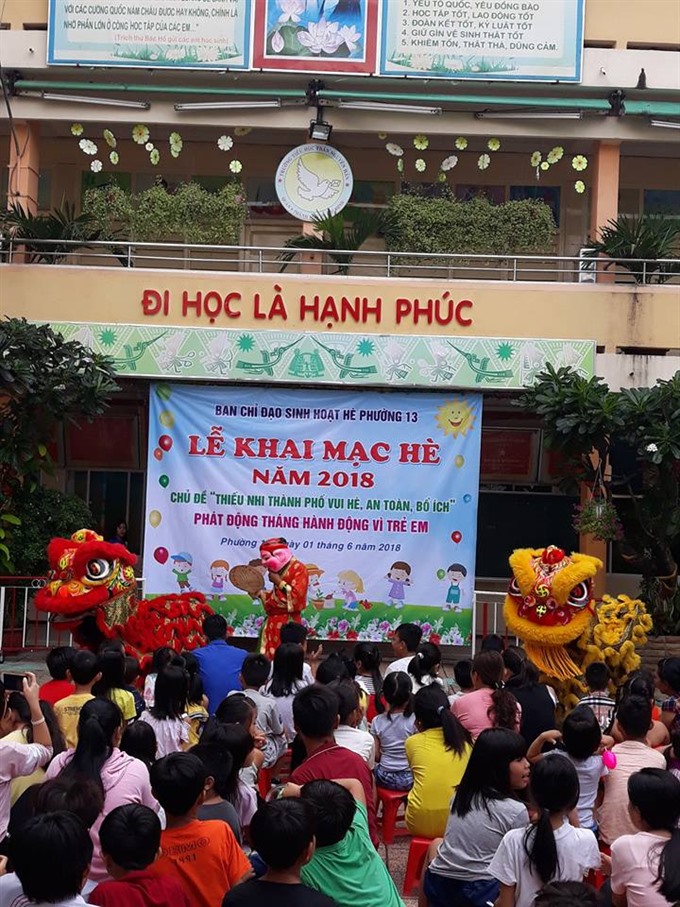 |
| Moving: Young performers from Long Nhi Duong, a dragon dance troupe in District 8, offer both new and traditional dances by performers aged 6 to 17 who are orphans or were once homeless. Photo courtesy of the troupe’s Facebook |
Viet Nam News
The Mua lan (kylin dance) is often performed by the ethnic Hoa (Chinese-Vietnamese) who account for around 4 per cent of HCM City’s population. Many of them live in Cho Lon (Big Market) in District 5. The dance is usually performed to bring luck and happiness during Tet (Lunar New Year), Mid-Autumn Festival, and at ceremonies to open a new business or build a new house. Anh Thu reports.
HCM City has dozens of professional dance troupes, including leading troupes Nhon Nghia Duong and Kien Thang Duong of Cho Lon (Big Market) in District 5 with 100-200 performers each. But Long Nhi Duong, a smaller troupe from District 8, is especially distinctive because its members are mostly poor children.
The troupe offers both new and traditional dances by members aged between 6 and 17 who are orphans or were homeless in the past.
“I decided to set up Long Nhi Duong 10 years ago. At that time, dance troupes refused to include children because performances can be difficult and dangerous,” Le Van Nam, founder and leader of Long Nhi Duong, said.
Nam was once a street kid who earned money by shining shoes, selling lottery tickets and collecting rubbish in Cho Lon.
When he was 14 years old, he worked as a trainee for Tinh Vo Duong, a kylin dance troupe in District 8.
Impressed by Nam’s size, which was bigger than kids of his age, the owner hired him straightaway.
One year later, he asked his master if he could leave the troupe and establish his own children’s troupe.
“I dreamed of setting up a troupe for poor kids, so I spent all my savings to buy a paper/fabric kylin head. The work was difficult, but I told myself to never give up,” Nam said.
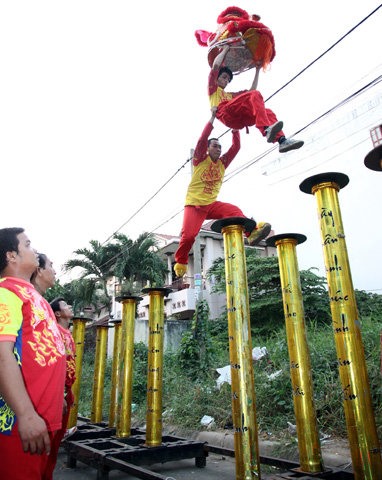 |
| Acrobatic: One of the featured kylin dance performances is Lan Len Mai Hoa Thung (Kylin Climbs Mountains). The dance presents a kylin head to the highest mountain. The lead dancer has to jump from the lowest pole of one metre high to the highest of 1.7 metres. There are 10 poles spaced metres apart. Photo Tan Phuc |
Long Nhi Duong’s first dancers were street kids aged 9-13 who travelled around the streets of Cho Lon offering free performances. Audiences gave the dancers food, clothes and small amounts of money.
Nam and his staff, who were mostly self-taught, also learned from professional performers in bigger troupes who wanted to help the kids earn a living from dance performances.
“Love, sharing and kindness are the good things that we gained from our masters and older colleagues,” said the 26-year-old.
Because of financial support received from organisations and individuals, 20 of the performers are now living in a house on Luong Ngoc Quyen Street in the city’s District 8.
“My parents are poor. I joined Long Nhi Duong four years ago to perform kylin dances for a living. Last year, I sent my mom VND2 million (US$90) from my savings,” said performer Tran Quoc Tri, 14, who lives in the outlying district of Binh Chanh.
“The Lan (kylin) is a symbol of power, wisdom and good fortune. It chases away evil spirits and brings happiness, longevity and good luck. To be a skilled performer, I have to devote my mind and body to the dance. This helps me become stronger and more confident,” he said.
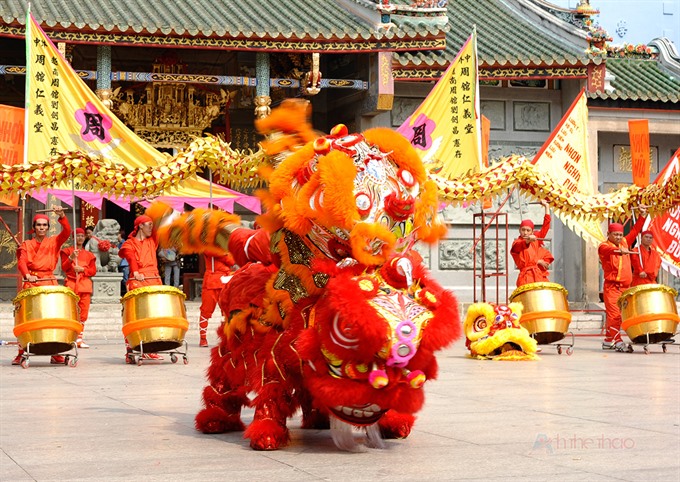 |
| Kylin performers wear black and white costumes that symbolise the balance of am (yin) and duong (yang), as well as a red fabric belts that show their passion for martial arts. During Tet (Lunar New Year), they use red clothes for luck. They play different drums to excite the audience and also perform circus acts. Photo anhthethao.vn |
Tri and his peers perform modern dances featuring ong dia (God of Earth) and dragon dancing together.
They spend time learning the art at night and perform dances at cultural centres and companies on the weekends. They spend their wages and money from gifts on food, clothes and costumes, among other items.
In the morning, they attend charity classes offered by volunteers at District 11’s Phu Tho Gymnasium. They study English with foreign teachers and play football and swim at the gym.
“The performers of Long Nhi Duong are required to go to these classes,” said Nam. “Kylin/dragon dancers should be educated and need to be professional in their art. Studying is the only key that can open their future.”
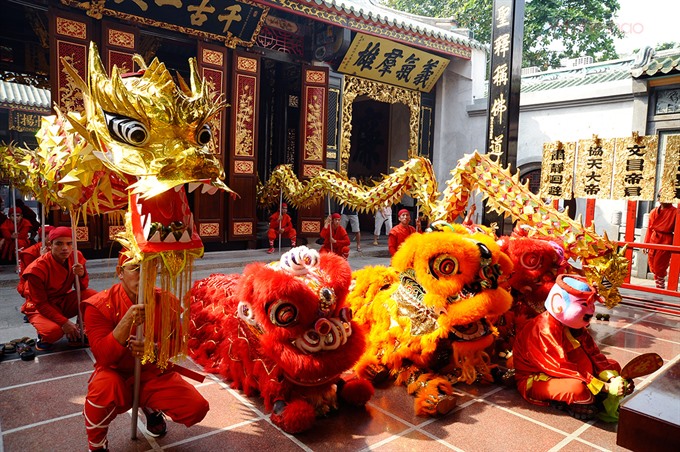 |
| Top troupe: HCM City has dozens of professional dance troupes, including leading troupes Nhon Nghia Duong and Kien Thang Duong of Cho Lon with 100-200 performers each. Photo anhthethao.vn |
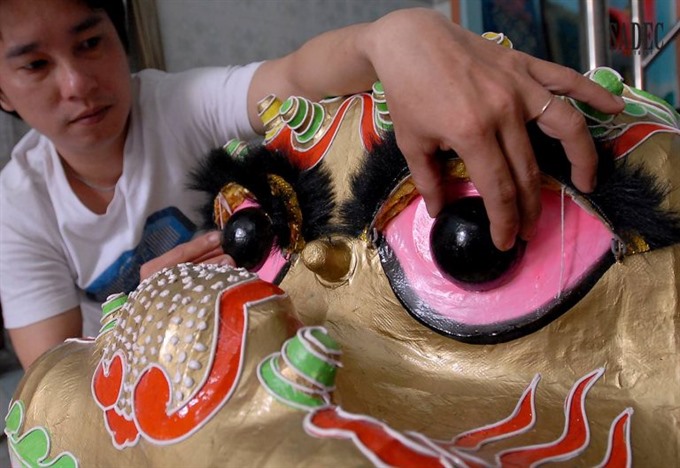 |
| Painstaking: Cho Lon artisans spend several hours to make a paper/fabric kylin head. Photo Huy Anh |
Tale of kylins
The kylin dance of the ethnic Hoa in Cho Lon consists of both traditional and modern performances.
Featured traditional dances include Cao Khong Hai Loc (Kylin takes gifts) and Lan Len Mai Hoa Thung (Kylin climbs mountains), which use at least 10 performers each.
In Cao Khong Hai Loc, dancers carry a small bag of money (offered by customers) over their shoulders at a height of 13-15 metres.
The lead dancer, who wears a kylin head, takes the bag with his mouth.
One of the outstanding performers of this traditional dance is Luu Hoan Phi of the Nhon Nghia Duong Troupe.
In the Lan Len Mai Hoa Thung dance, a kylin head is taken to the highest mountain.
During the dance, the performer has to jump from the lowest pole of one metre high to the highest one of 1.7 metres. There are 10 poles spaced metres apart.
Skilled performers spend two years practising this difficult dance.
Masters of the dance and veteran performers at leading troupes have taught these techniques and skills to younger generations for hundreds of years.
With modern dance performances, martial art is featured. Martial art master Chau Chi Hung of the Trung Nghia Duong Troupe, for example, uses his bare hands to chop a durian or a brick into two pieces.
The Thang Nghia Duong Troupe is famous for its coconut-breaking performances.
Over the last 40 years of the troupe’s existence, Huynh Chi Dan and Huynh Gia Buu have been the only members of the troupe who can perform the act.
Both actors use their chanters (a large musical instrument) to break a coconut into small pieces.
“Using hands to break a coconut is not difficult. Using chanters is the height of the art,” said martial art master Buu.
Kylin dance performers wear costumes in black and white to indicate a balance between am (yin) and duong (yang), and a red fabric belt which symbolises their passion for martial arts.
During the Tet (Lunar New Year) holidays, they use the colour red to bring luck, and play different drums to excite audiences. They also perform as circus artists.
“In the 1980s, I lived in a small alley of Luong Nhu Hoc Street in Cho Lon. I first watched a kylin dance performed by the Nhon Nghia Duong Troupe during Lunar New Year festival when I was a 13 years old,” said Phan Hong Hai of Tan Binh District.
“I thought kylins were real until I saw the performers take the papier-mache kylin heads and clothes out!” he added. “I’ll never forget the sight and sound of the dances.”
“Hotels, companies and restaurants often invite kylin dance troupes to perform during Tet because they want to welcome the new year and have luck for the entire year. After watching a kylin dance on the street by chance, visitors will have good luck in their life and career,” he said.
“The kylin dance of the Hoa in Cho Lon is a mixture of dance, martial art and passion. I think the Vietnamese dragon dance art has developed very well,” said master Luu Kiem Xuong, head of Nhon Nghia Duong, who has more than 30 years of experience.
The Nhon Nghia Duong troupe was establised in 1973. Since the 1990s, it has won several top prizes at international kylin dance festivals.
In 2000, the troupe won the second prize at the International Kylin Dance Contest in Thailand, and in 2008, it received the third prize at the International Kylin Dance Festival in Malaysia, following the top winners Malaysia and Singapore.
Earlier this year, the Tinh Anh Duong troupe from HCM City won first prize at the 11th International Lion Dance Competition in Singapore.— VNS
OVietnam